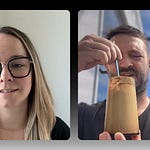Some metaphors stick with you—pun intended! Seth Godin wrote about the difference between nails, glue, and screws. At first glance, it’s a simple construction analogy. But as Holly and Daniel unpacked it, we realize it’s a surprisingly sharp framework for how we make decisions, build projects, and even design relationships.
Let’s break it down.
Nails: Quick Wins, Quick Losses
Nails are easy. Fast. Almost anyone can swing a hammer.
That’s why so many projects start this way - we just need to get something in place. Ship the feature. Launch the campaign. Write the draft.
The danger? Nails don’t hold forever. They’re brittle. They split under stress. They’re fine for a test, but risky for the foundation.
Sometimes you need nails. But if your whole house is nailed together, don’t be surprised when it shakes.
Glue: Commitment Without Flexibility (…also so sticky!)
Glue feels stronger. It’s a commitment. Once you bond two surfaces, undoing it leaves damage.
Holly pointed out that some people like glue—it’s less precise, less technical, and creates the feeling of “we’re sticking with this.” Others hate it because it locks them into a decision they can’t reverse.
That’s the tension: glue is powerful, but it’s permanent. It’s great for marriage; maybe not for your MVP launch.
Screws: Resilient, Skillful, and Reversible
Screws require precision and skill. They also require tools, patience, and the right kind of anchor.
But screws are resilient. They create strong, lasting bonds—and they can still be undone. That’s what makes them the sweet spot.
In product development, this is the difference between sloppy shipping (nails), over-engineered glue traps (glue), and well-built systems that can evolve (screws). Holly called out “tech debt” as a clear example: ship with nails, but know you’ll pay the price later. Or use screws, even if it costs you time up front.
In relationships, screws look like healthy boundaries: strong, durable, but not suffocating. You can revisit, renegotiate, or realign—without tearing the whole thing apart.
The New Frontier: Disposable Software, Flexible Screws
Here’s what’s fascinating in today’s world: screws are getting easier.
Daniel pointed out that with AI prototyping and low-code tools, we can screw things together fast, test them, and unscrew them without wasting months. What used to require nails (temporary hacks) or glue (overcommitment) can now be built in a reversible, resilient way from the start.
That’s a shift worth noticing. The right “fastener” isn’t just about tools—it’s about how the world of building is changing. And the better we get at choosing, the stronger (and more flexible) our projects become.
So Which Are You Reaching For?
Here’s the Friday reflection:
Are you defaulting to nails because they’re fast and easy?
Are you over-gluing because commitment feels safe?
Or are you taking the time to screw things in—building resilience and reversibility into your work?
The magic, as always, is in discernment. Seth was right: nails, glue, and screws aren’t just tools. They’re choices about how we build.
And the choices add up. To projects that either collapse under stress… or last for years.
💬 What about you? When you think about your work, your projects, or your team—are you nailing, gluing, or screwing? Let us know in the comments!
















